Spellbinder has arrived safely in Palmeira, Sal, Cape Verde after 5 and a half days at sea, having left Tenerife on Mon 12th November. We had a good passage, with a bit of adventure and many new experiences.
We left Tenerife having checked out with immigration, and found a nice beam wind to clear the immediate island. A few miles off, however, the seas were confused with swell and winds crossing providing a bumpy few hours. The wind was consistently behind us though, and we experimented with various sail sets as we tried to make progress. The first night we goose-winged, with consequent rolling keeping us all awake, and self-stowing all my gear! The next day we pulled out the Parasailor and gave it a really good run. It is an excellent sail, and I tend to fly it without pole or mainsail with two guys and two sheets, with one of each taking up the tension on each side.
The sail allowed us to sail virtually dead downwind and has the added advantage of lifting the bow which limits rolling. We sailed fast and straight with it, and it is remarkably stable in anything above 8 or 9 knots of true wind. The difficulty comes when it needs to be taken down, and we got caught out in a squall on the second night at around 2am. All hands on deck as the wind speed reached 26 knots – the limit being 20, really. Thanks to the determined efforts of Simon and Crispin, and a little help from the anchor windlass, we got it down but not without a 2 metre tear at the bottom. I think I shall be much more reticent flying it at night, when the squalls come; dead downwind with it during the day, but bear away if necessary and broad reach with white sails during the night I think.
The middle period of the voyage was taken over by running repairs – to the Parasailor (excellent job with tape and the Singer sewing machine – thank you Charles for introducing me to the concept of thread tension), to chafe on the bimini (Singer again, I’m getting good at it), to a solar panel, a dive down to clear a broken sheet attached to a joint in the rudder (thanks Charles – always handy to have a free diver on board) and various modifications to our arrangements of sheets and guys as we learned what was best. It is certainly the most prolonged period of dead downwind sailing I have done and will be really useful experience for the Atlantic.
As we progressed south the temperature increased and the wind died away, leaving us to motorsail or motor the final 36 hours. Highlights were toasting our arrival in the Tropics; almost catching a large dorado but landing a smaller one; getting up to finding a dozen flying fish on deck, and frying them for breakfast, and seeing a whale spout. We settled into a good routine, and ate and drank well.
We made a careful night entry by moonlight into Palmeira and anchored outside the two dozen yachts which are here. In the morning the swell had got up and we were a bit to close to the beach; luckily with a bit of help from a local we were able to weigh anchor and take up a buoy away from the swell, more in the centre of the harbour. The surf is amazing in what are 4 metre swells caused by strong weather north of the Canaries. Two hours at immigration followed (we are in Africa, after all…) and a trip to the airport to bid farewell to Charles, who somehow will contrive to be on some Army ranges in west Wales tomorrow morning! Crispin departs tonight and Simon and I will head west to explore the neighbouring islands over the next few days, before aiming for Mindelo, Sao Vicente for Thursday and a final crew change prior to the Atlantic crossing.
Here are the photos which try to tell the tale of our trip down here:

Leaving Tenerife – Charles (L) and Simon (R)

The skipper disproportionately happy with his new 12 volt rechargeable coffee grinder

We baked bread most days, and made yoghurt. Crispin’s loaf (shown) and Simon’s rolls won the Great Spellbinder Bake-Off
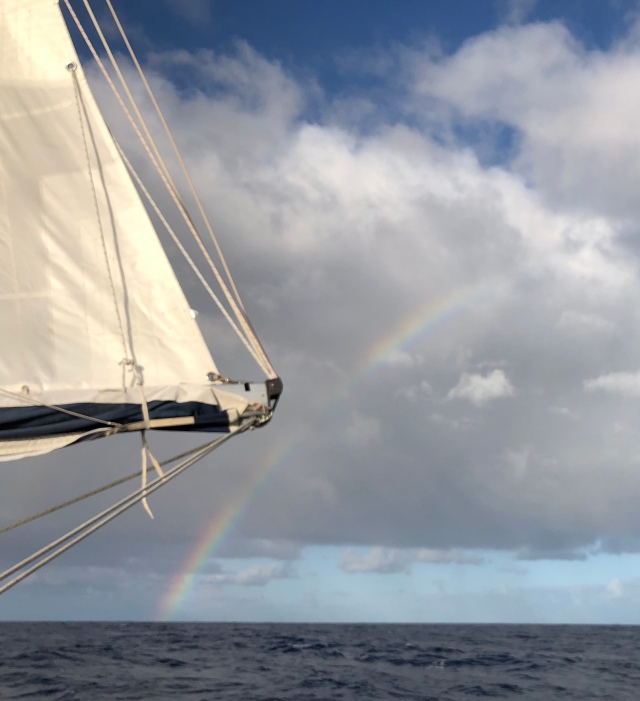
Tropical Atlantic rainbow. The weather was cooler and cloudier than I had expected
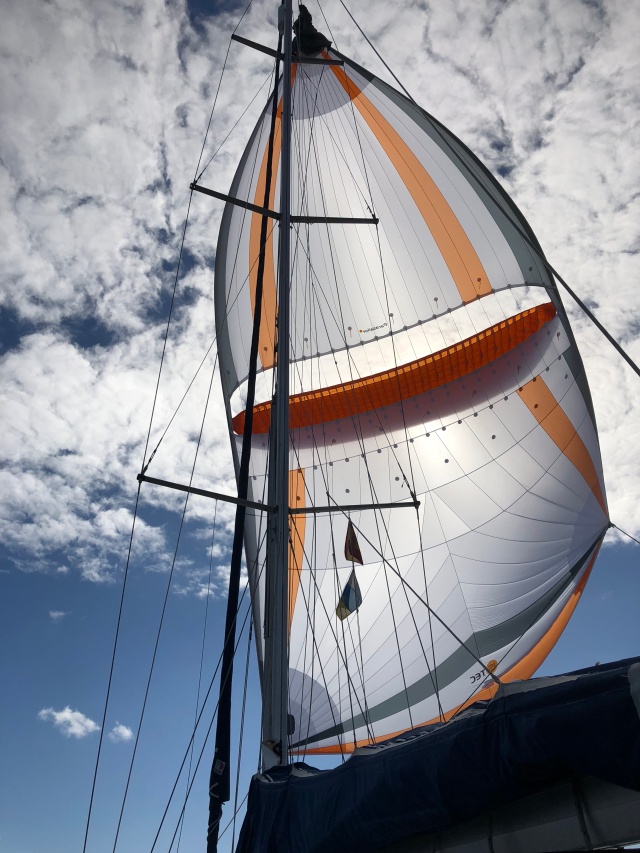
The Parasailor doing its stuff

Running repairs to the aforementioned Parasailor. Thank you Charles for actually reading the manual and alerting me to the importance of Fred Tension…

Celebrating our arrival in the Tropic of Cancer. 6pm sun downers became a regular part of our routine as we reflected on the voyage so far
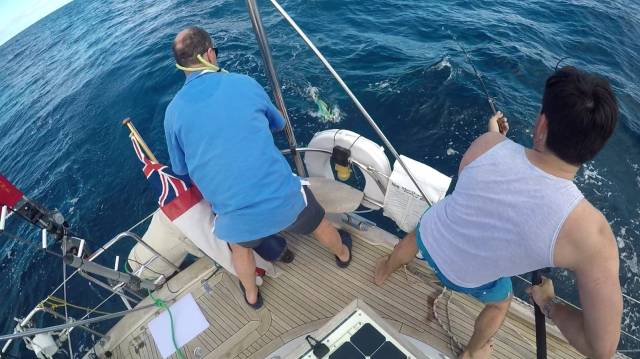
The big one that just got away – a beautiful, probably male dorado with amazing rainbow colours…

…and the one that didn’t. A smaller female we think

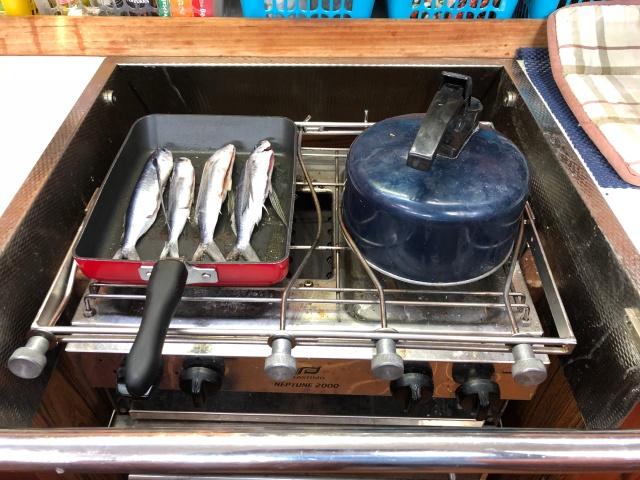
The morning haul of flying fish – fried in olive oil, they made a delicious breakfast

As we neared Cape Verde we saw squadrons of these fish flying around
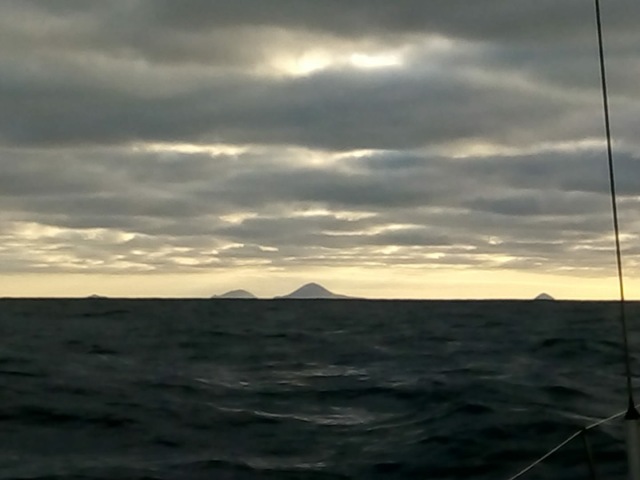
Sal sighted. We had a cautious arrival, as the buoyage lights don’t always work and there have been many recent changes

Palmeira harbour. Spellbinder is the only yacht with a burgee, now that there aren’t any British yachts present! There is considerable surf in the background

Tuna market on the quayside – gory!


The editor at work

Excellent blog instalment and some great photos. – flying fish for breakfast is definitely on my ‘must do’ list!
LikeLike
Congratulations Spellbinder and all who sailed in her.
And another mention in YM; one more time and you’ll be buying the champagne!
LikeLike
Well done Spellbinder and ye hearty crew! Quite a trip. Those flying fish look delicious. Love the photos Nick 👌 Ant
LikeLike
Been thinking about your parasailor trouble: many years ago my father took us sailing and we used two spinnaker booms on the spinnaker. Attached to the booms were a guy and a sheet each, and the clews were attached to the outboard ends of the booms. There was a quick release mechanism so that one clew could be let fly enabling the safe retrieval and storage of the sail. Happy sailing. Very interesting blogs, thank you.
LikeLike